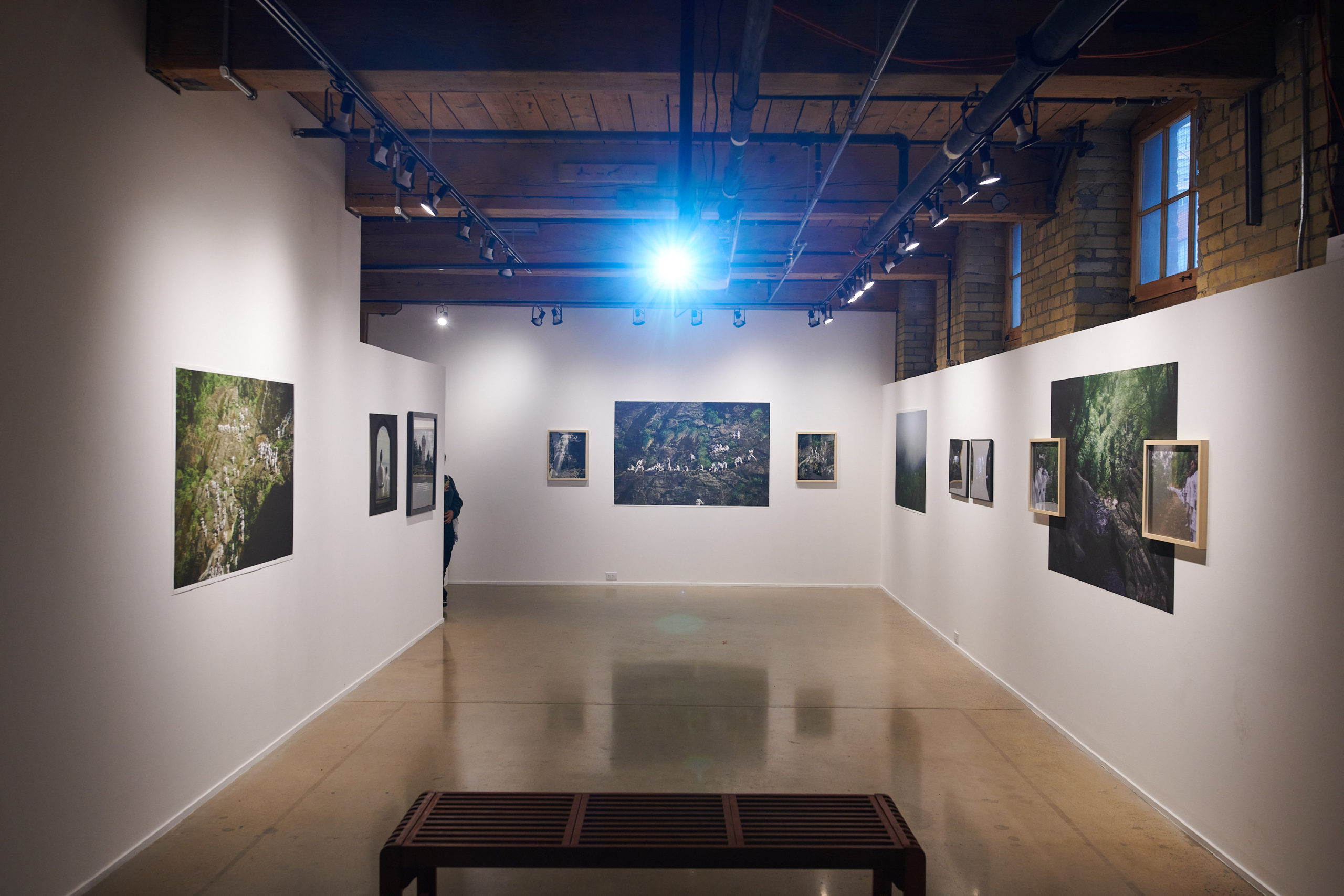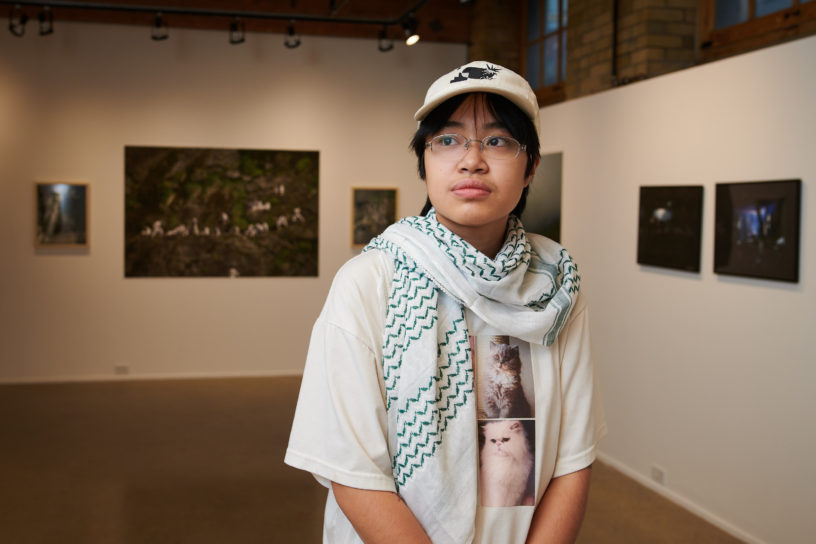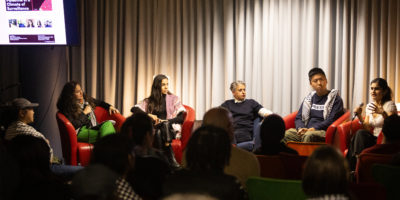By Teresa Valenton
Out on the wondrous terrains of the Bạch Mã mountains, over 280 karate-do students embarked on their final journey to complete their training. Mostly between 13- and 25-year-olds, the annual summit of survival is a testament to their skills and spiritual relationship with the land.
Following a 20-kilometre trail, each student proudly marched, barring heavy bags on their backs. Surrounded by lush greenery and waterfalls that flow through the crevices of the land, a photographer followed to document each fleeting moment. What began as following his father’s past transformed into an act of healing, exploration and decolonization.
Toronto Metropolitan University (TMU) fourth-year image arts film studies student Trâm Anh Nguyễn’s first off-campus solo exhibition Black Belts on Bach Ma Mountain (Đai Đen trên Núi Bạch Mã) captures the students’ journey into the Bạch Mã mountains of Central Vietnam. The exhibit is on display at ArtSpace TMU between Sept. 23 and Nov. 2.

Silently commanding attention to each work displayed, Trâm Anh’s works speak to those whose nations have been greatly impacted by colonial powers. Each component of the exhibition visually transports viewers to the Vietnamese mountainside that has long felt the effects of intense warfare and collective trauma of the Vietnamese people.
Trâm Anh said the journey and process was meaningful for him because it represented so much of Vietnamese history in one mountain space.
“A lot of traditional Indigenous knowledge and philosophies have always treated nature as their kin. Even in Vietnam, it was really the Western colonizers that made us believe that we are separate from nature, that humans are different,” he explained.
Trâm Anh followed the trip along with his father, who was once a student at the school and earned a black belt.
With two cameras on his side and nearly no electricity outlets, getting the shots proved to be much more difficult than anticipated. Since there was only one opportunity to charge the cameras, each frame needed to be intentional.
On the journey upwards, Trâm Anh said they rarely came across buildings. At the sites where they settled, the journey downwards to reach a charger would have been a long way down.
Draped in ethereal clouds and flourishing biodiversity, the landscape represents life beyond bloodshed. Named for the white, horse-like clouds that have covered their peak, these mountains have been silent witnesses to the aftermath of colonial powers.
“These mountains have been silent witnesses to the aftermath of colonial powers”
The site the students trained on was also used as a retreat from the nearby city of Huế during the French colonial period in Vietnam. The country was invaded in July 1857 at the command of Napoleon III and was the result of missionary propaganda, an upsurge in French capitalism and a desire for overseas markets.
In the decades that followed, the mountains became a base for the American military during a two-decade-long war. Referred to as the American War or the Vietnam War depending on the speaker, the armed conflict was triggered primarily by the United States (U.S.) interfering with the Vietnamese people’s right to self-govern in an effort to stop the spread of communism.
The Nghĩa Dũng Karate-do school was founded by Nguyễn Văn Dũng—also known as Thầy (Master) Dũng. The over-80-year-old man established the school in 1978, nearly three years after the American War, to share the sense of freedom and peace he found in the mountains.
In a recorded interview, Thầy Dũng told Trâm Anh that Bạch Mã was once reduced to only reeds. The landscape still bears the scars of fighting, including undetonated bombs and chemical defoliants.
During the war, the U.S. dropped three times more bombs in Vietnam than every country in Europe during World War II. They also bombed surrounding neutral countries such as Laos—which made it the most bombed country per capita.
Vy Nguyễn, Thầy Dũng’s daughter and a former student, said the mountains also create a space where some can heal from the trauma.
“Resilience in your life and the happiness and love of nature will keep you positive even in negative times,” she said.
As one of three girls on the trip 20 years ago, she described the journey as “wonderful.” Though it has become a distant memory, Vy said her youth is intertwined with the Bạch Mã mountains.
“The dream is to be there with my dad, carrying my backpack, singing and reading poems very happily,” she said.
“Resilience in your life and the happiness and love of nature will keep you positive”
Yung Tran, Thầy Dũng’s son-in-law said the audience sees black belts, uniforms and fighting but not the depth behind the students.
“What made them want to follow or to learn,” he asked. “Though what you are seeing here is a lot of karate martial arts, knowing my father-in-law, the training is not just karate. It is not just teaching people how to fight, but rather how to become a good person and to live.”
What is shown in Trâm Anh’s photos is a glimpse into the karate-do training on the Bạch Mã mountains. However, the viewers are highly encouraged to think beyond.
Katy McCormick, associate chair at the School of Image Arts said she is thrilled by Trâm Anh’s exhibit.
“The work in this gallery tonight talks about the way in which images speak to one another across media,” she said. “Still and moving images have always been in very traditional circles, a separate thing, but they are beautifully integrated in this show.”
Coming out of his gap year before his fourth year, Trâm Anh sees this show as a testament to two years of hard work.
“Sometimes when you have time to slow down, it is actually where you grow the most,” he explained. “It was probably one of the best decisions of my life and made me realize that I need more balance in mine as well.”
In observing the ever-changing landscape of the Bạch Mã mountains, Trâm Anh compared the slow but inevitable lessons from the summit to his own work. Sitting down on a white seat along the corner of his first off-campus solo exhibition space, he finally had the opportunity to reflect.
“All of those trees in the forest do not grow overnight,” he said. “But at the end, they still get to where they are.”











Leave a Reply